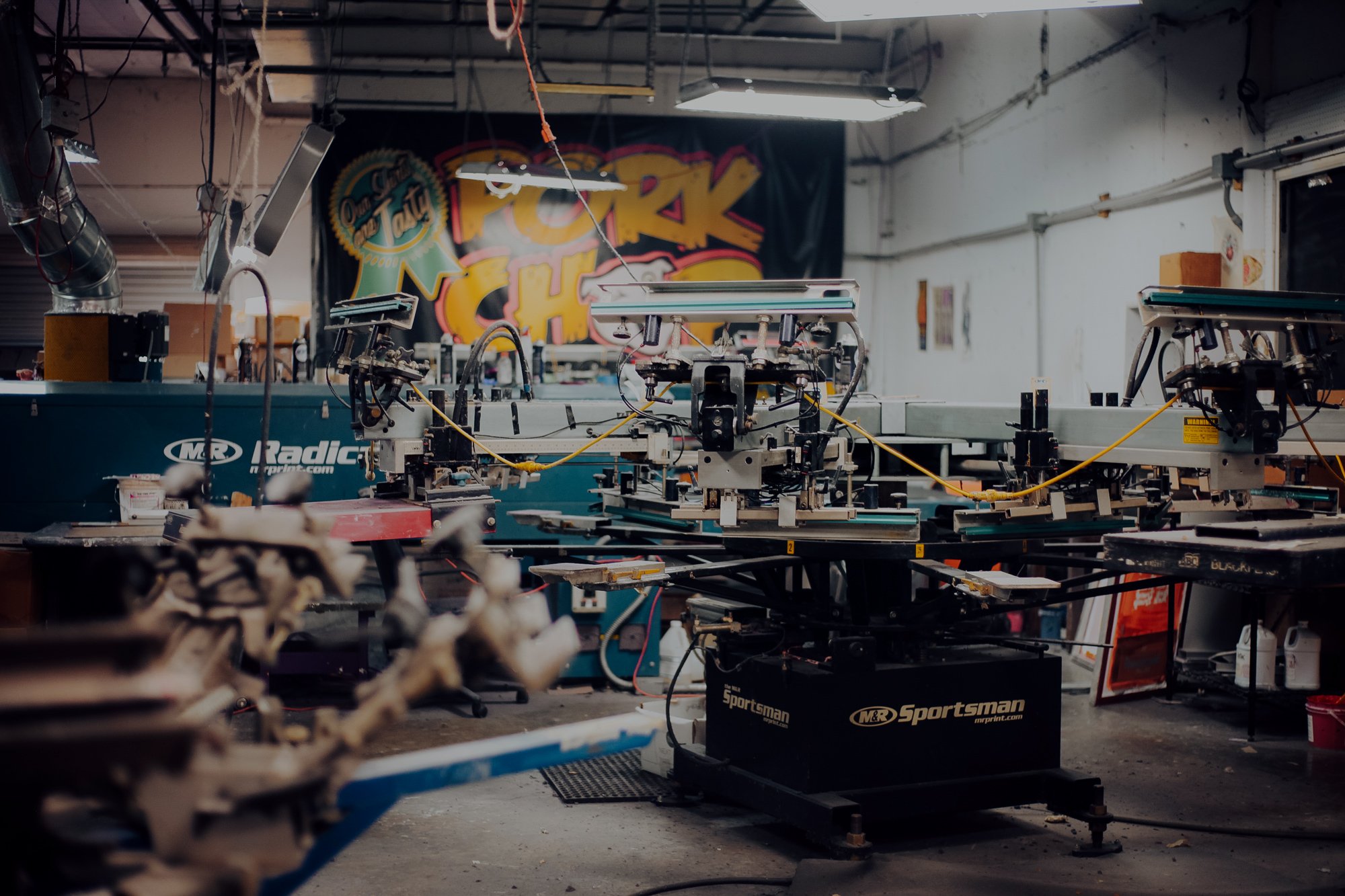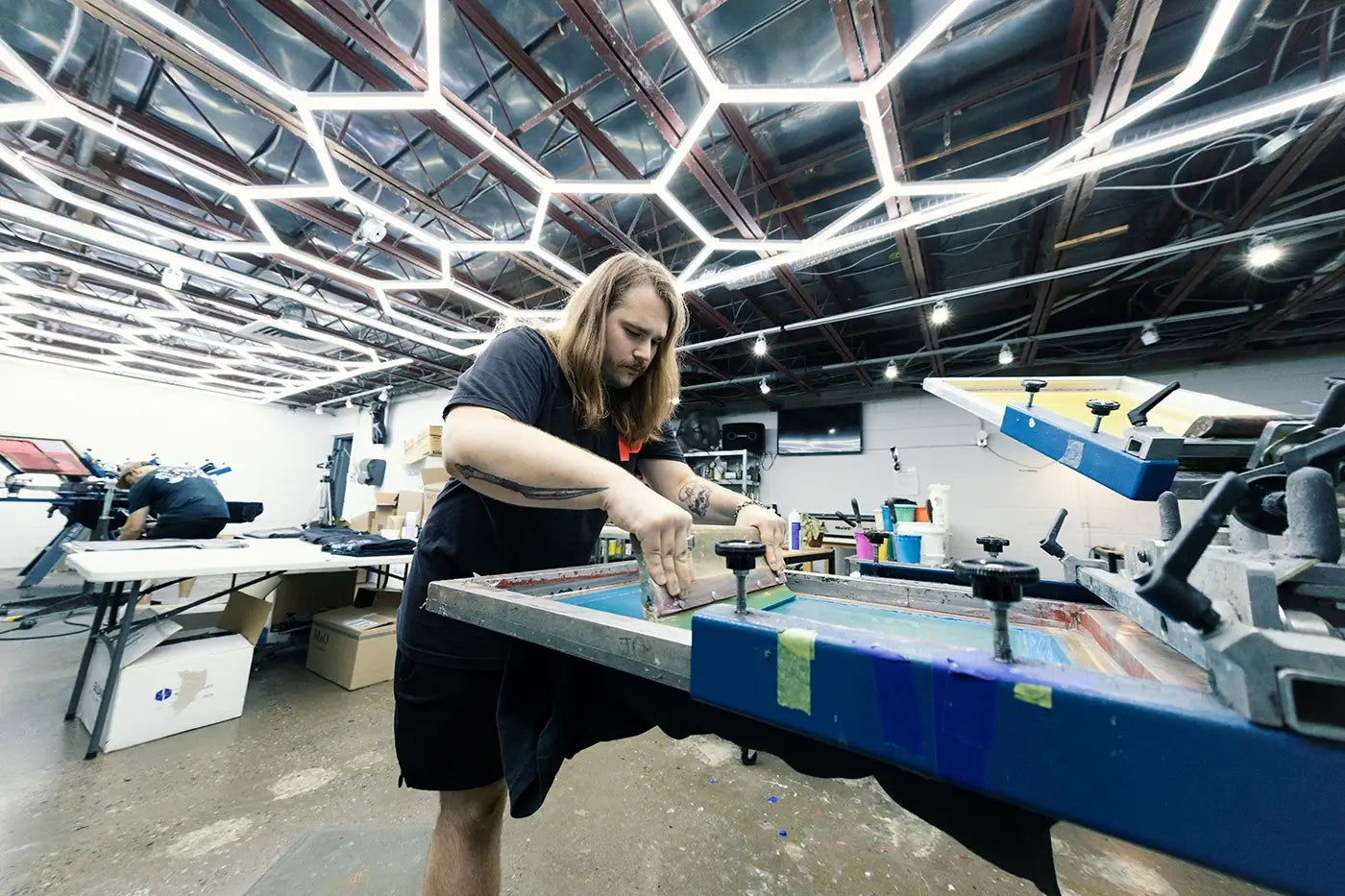Detailed Silk Screen Printing for Custom Art Apparel
Wiki Article
Screen Printing Uncovered: Whatever You Required to Find Out About Tee Shirt and Garment Printing Strategies
Screen printing is a fascinating approach that combines art with method, supplying endless opportunities for creative thinking. Prepared to discover the essential components that make display publishing an art form?
The Essentials of Screen Printing: How It Works
When you dive right into screen printing, you'll discover it's both an art and a science. At its core, display printing entails creating a stencil, or screen, that allows ink to pass through just in certain locations.Position the screen over the textile, after that use a squeegee to push ink through the display onto the garment. Each step is important, and grasping them will boost your display printing abilities, transforming straightforward garments into one-of-a-kind, expressive pieces.
Kinds Of Screen Printing Methods
As soon as you realize the fundamentals of display printing, it's time to explore the numerous techniques that can boost your layouts. One popular approach is typical screen printing, where ink is pushed through a stenciled display.One more option is plastisol printing, recognized for its toughness and brilliant colors, making it a favored for lots of brands. Experiment with halftone printing to produce gradient effects and elaborate designs.
Necessary Equipment for Screen Printing
To achieve magnificent results in display printing, having the right devices is basic. You'll need a strong screen printing frame, which holds the mesh that moves your design onto the garment. Next, spend in top quality squeegees; these are vital for applying ink equally throughout the screen.Picking the Right Inks and Materials
When selecting inks and products for screen printing, you need to take into consideration the kind of ink that works ideal for your job. Think of fabric compatibility to guarantee your designs look last and excellent lengthy. Additionally, discover eco-friendly ink choices to make your printing procedure a lot more lasting.Types of Screen Inks
Selecting the appropriate screen ink is crucial for achieving lively, durable prints that fulfill your task's needs. There are a number of kinds of display inks to check out. Plastisol ink is preferred for its convenience and convenience of usage, providing excellent shade opacity on dark textiles. Water-based ink, on the various other hand, uses a softer feel and is environmentally friendly, making it suitable for those wanting to lessen their environmental impact. Discharge inks eliminate color from the textile, causing a soft, vintage appearance yet require certain handling. Specialized inks, such as glow-in-the-dark or metal, can add distinct impacts to your layouts. Evaluate your project requirements and select the ink that lines up finest with your preferred outcome.
Textile Compatibility Considerations
Recognizing textile compatibility is important for attaining high-quality display prints, particularly because different products respond distinctly to different inks. Constantly check your inks on example fabric to ensure they stick effectively and preserve color stability. Additionally, maintain in mind that fabric weight and structure can affect the last end result, so choosing the best ink and material combination is essential for your project's success.Eco-Friendly Ink Options
Environmentally friendly inks are becoming a prominent choice for display printers who want to minimize their environmental impact while preserving quality. When choosing inks, think about water-based inks, which are less hazardous and much easier to cleanse up contrasted to conventional solvents.In addition, try to find inks made from renewable energies, such as soy or vegetable-based options. By picking the appropriate inks and products, you'll not only produce stunning styles but likewise contribute to an extra lasting printing process. Make the switch, and your prints will certainly reflect your dedication to the setting!
Preparing Your Design for Screen Printing

Submit Style Demands
To ensure your layout looks sharp and vibrant on material, you'll require to pay very close attention to submit format requirements for screen printing. Beginning with vector documents like AI or EPS, as they can be scaled without shedding quality. If you make use of raster images, opt for high-resolution files, such as TIFF or PNG, preferably at 300 DPI. Prevent using JPEGs, as they can shed quality when resized. Likewise, ensure your style has a transparent background to stop undesirable white edges on your prints. Finally, maintain shade settings in mind; CMYK is conventional for display printing, so convert your RGB creates as necessary. By adhering to these guidelines, you'll establish your artwork up for an effective print.Shade Separation Techniques
Shade separation is an important action in preparing your style for screen printing, and mastering it can considerably enhance your print top quality. You'll require to damage your design right into private shades, as each color needs a separate display throughout printing. Beginning by determining all the shades in your layout and create layers for each one. You can use software program like Adobe Photoshop or Illustrator to separate and separate colors effectively. read the full info here Be specific to save each layer as a separate data, commonly in a layout like TIFF or PSD. This accuracy not just guarantees accurate color depiction however additionally enhances the printing process. By focusing on shade splitting up, you'll attain lively and specialist outcomes in your screen-printed garments.Resolution and Size
Achieving the very best lead to screen printing starts with assuring your layout has the right resolution and size. Preferably, your art work ought to be at the very least 300 DPI (dots per inch) for sharp, clear prints. Your last item could look amateur and pixelated. if you make use of lower resolution.When it pertains to size, consider the dimensions of your print location. Design your artwork to match the final print dimension, preferably developing it in the actual measurements you'll be printing. In this manner, you'll stay clear of any unanticipated scaling issues.
Always inspect your layout in both vector and raster styles. Vector graphics can be scaled without losing high quality, making them excellent for screen printing. Preparing properly will ensure your layout looks fantastic on every garment!
Step-by-Step Display Printing Process
Screen printing is a vibrant process that allows you to create lively layouts on different surfaces. To get going, you'll need a screen, solution, and your chosen ink. Prepare your screen by cleansing it completely. Next, use the emulsion equally and let it completely dry in a dark location. As soon as completely dry, reveal your screen to light with your layout put on it, which will set the solution where the light hits, producing a stencil - screen printing kit.After cleaning out the unexposed solution, your screen prepares. Set it up on your printing surface area and align your garment below it. Pour ink onto the display and make use of a squeegee to push the ink through the stencil onto the fabric. Raise the screen carefully and let the print dry. Lastly, heal the ink using warmth to assure longevity. That's it! You've effectively screen published your layout.
Tips for Successful Display Printing Projects
While you're diving right into your display printing projects, bear in mind that prep work is crucial to success. Beginning by collecting all your products-- inks, squeegees, garments, and displays. A clean work space helps protect against unwanted errors, so clean up prior to you begin.Following, verify your artwork is high-resolution and effectively sized for your garment. Evaluate your display for proper exposure and tidy it extensively to stay clear of smudges. When mixing your inks, adhere to the manufacturer's guidelines to achieve the right consistency.
Throughout printing, use also pressure with your squeegee for consistent results. Don't hurry; find out take your time to confirm each print satisfies your standards. After printing, allow your garments completely dry totally before managing or packaging them.
Last but not least, constantly keep a sample of your help future recommendation. In this manner, you can evaluate your development and enhance your techniques with time. Satisfied printing!

Regularly Asked Questions
How Lengthy Does It Require To Establish a Display Printing Job?
Setting up a screen printing task usually takes around 30 minutes to an hour. You'll prepare the displays, mix inks, and change the press. The moment differs based upon intricacy and experience, so remain arranged!Can I Publish on Various Textile Keys In Utilizing the Exact Same Method?
Yes, you can print on different fabric types making use of the very same strategy, but you'll need to readjust your inks and setups. Some textiles take in ink in a different way, so exploring warranties the ideal outcomes for every material.What Are Common Mistakes to Avoid in Display Printing?
When display printing, avoid common errors like utilizing the wrong ink, overlooking proper exposure times, or skipping pre-press Source checks. Always evaluate your configuration and maintain clean screens to ensure quality results each time.Just How Can I Properly Tidy and Keep My Screen Printing Devices?
To properly tidy and preserve your screen printing equipment, you must regularly clean displays with ideal solvents, check mops for wear, and assure all tools are saved dust-free and dry. Uniformity enhances and stops expensive fixings efficiency.Is Screen Printing Eco Pleasant Contrasted to Various Other Techniques?
Screen printing can be more ecologically pleasant than other methods, especially if you utilize eco-conscious materials and water-based inks. By picking sustainable products and techniques, you decrease waste and minimize your impact on the planet.Display Printing Uncovered: Whatever You Need to Know About Tee and Garment Printing Techniques
At its core, screen printing entails producing a pattern, or display, that permits ink to pass via just in certain locations. Position the display over the fabric, then utilize a squeegee to press ink with the display onto the garment. One popular method is standard screen printing, where ink is pushed through a stenciled display.When picking inks and products for display printing, you require to take into account the kind of ink that works finest for your task.
Report this wiki page